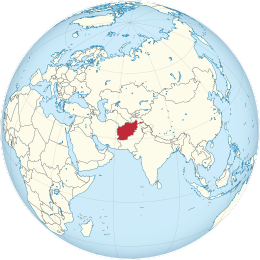Commons:Copyright rules by territory/アフガニスタン
|
著作権に関する諸規則: アフガニスタン ショートカット: COM:アフガニスタン | |
 | |
 | |
| 保護期間 | |
|---|---|
| 標準 | Life + 50 years (Afghan calendar) |
| 写真 | 公表後50年 |
| 匿名または不明 | 公表後50年 |
| 視聴覚作品 | 公表後50年 |
| 没後出版 | 公表後50年 |
| その他 | |
| 風景の自由 | No |
| 一般的なライセンスタグ |
{{PD-old-auto}} {{PD-Afghanistan}} |
| 条約 | |
| ベルヌ条約 | 2018年6月2日 |
| 世界貿易機関 | 2016年7月29日 |
| URAA回復期日[1] | 2016年7月29日 |
| WIPO著作権条約 | 2021年2月9日 |
| [1]通常、アメリカにおいて著作権保護可能な種類の作品であり、1928年12月31日以降に発表され、なおかつURAA期日において本国で著作権が保護されていた作品は、アメリカにおいて著作権保護されています。 | |
This page provides an overview of copyright rules of Afghanistan relevant to uploading works into Wikimedia Commons. Note that any work originating in Afghanistan must be in the public domain, or available under a free license, in both Afghanistan and the United States before it can be uploaded to Wikimedia Commons. If there is any doubt about the copyright status of a work from Afghanistan, refer to the relevant laws for clarification.
背景
Afghanistan came under loose British control in the late 19th century. After the Third Anglo-Afghan War in 1919 the country regained independence. Since then the country has suffered from coups, invasions and civil war.
Afghanistan has been a member of the World Trade Organization since 29 July 2016, the Berne Convention since 2 June 2018 and the WIPO Copyright treaty since 9 February 2021.[1]
As of 2018 the World Intellectual Property Organization (WIPO), an agency of the United Nations, listed the 2008 Law Supporting the Rights of Authors, Composers, Artists and Researchers (Copyright Law) as the main IP law enacted by the legislature of Afghanistan.[1] WIPO holds the text of this law in their WIPO Lex database.[2]
The Taliban government since 2021 is unrecognized, but continues to enforce existing copyright law.
保護期間
Under the 2008 Copyright Law, protection is as follows:
- Works published or broadcast during the life cycle of the author shall be protected 50 calendar years after his/her death unless the author has decided differently.[2008 Article 16.1.1]
- Joint works published or broadcast during the life cycle of the authors shall be protected for 50 years after the death of the last author.[2008 Article 16.1.2]
- Works published or broadcast with metaphorical (pseudonym) names shall be protected for 50 years after the first year of the publication.[2008 Article 16.1.3]
- Works not published during the life cycle of the author and in the case of the joint work, that have not been published during the life cycle of the last author, shall be protected for 50 years effective from the first year of publication and broadcast.[2008 Article 16.1.4]
- Audiovisual works shall be protected for 50 years effective from the first year of the publication or broadcast.[2008 Article 16.1.5] If the work is not published or broadcast, it shall be protected for 50 years from fixation.[2008 Article 16.2]
- Photography and painting works shall be protected 50 years effective from the first year of publication and broadcast.[2008 Article 16.1.6]
伝承
Public Culture (National Folklore) is an expression which include characterized principles of traditional artistic heritage originated or developed by a group of people in the State which reflect their artistic heritage and include the following expressions: Oral expressions such as tales, popular poetry and riddles; Musical expressions: include popular songs accompanied by music or without music; Motion expressions, include popular Atans (national dance), plays and other special popular artistic and ritual forms; Identical expressions such as products or popular art such as drawings with lines and colors, engravings, statuary, pottery, needlework, woodwork, mosaic, metalwork, jewelry, knitting, carpet weaving and other textiles; Musical instruments; Different architectural works.[2008 Article 3.23]
National folklore shall be the public property of the State, the Ministry of Information and Culture, shall protect National Folklore by all legal means.[2008 Article 45]
コピーライト・タグ
- {{PD-Afghanistan}} – public domain (no existing copyright law)
風景の自由(FOP)
![]() 、個人での利用のみ
、個人での利用のみ
Article 39 permits reproductions of published works "for personal use only". Article 40 only allows noncommercial uses of extracts of works for teaching purposes. Article 42 is a close provision that allows "the press or other information media" to publish "works displayed openly to the public, provided that the name of the author is clearly indicated," but the types of works are restricted to "speeches, lectures, as well as legal proceedings or similar works," not architectural works or statuaries.
Threshold of originality
According to the 2008 Copyright Law, work that may be protected includes: Photography work that has been created using an innovative mode; Innovative work of handicraft or industrial art (carpet designs, rugs, felt carpet and its attachments etc.); Innovative work which has been created based on the public culture (folklore) or national cultural heritage and art.[2008 Article 6(1) items 7-9]
切手
参照:Commons:切手
![]() Copyright expires 50 years after first put in circulation.[2008 Article 16.1.6]. For stamps published more than 50 years ago (before 1 January 1974) use {{PD-Afghanistan}}.
Copyright expires 50 years after first put in circulation.[2008 Article 16.1.6]. For stamps published more than 50 years ago (before 1 January 1974) use {{PD-Afghanistan}}.
関連項目
出典
- ↑ a b Afghanistan Copyright and Related Rights (Neighboring Rights). WIPO: World Intellectual Property Organization (2018). Retrieved on 2018-11-08.
- ↑ Law Supporting the Rights of Authors, Composers, Artists and Researchers (Copyright Law). Afghanistan (2008). Retrieved on 2018-11-08.